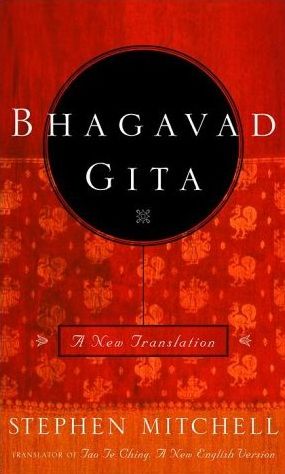The response to my Gita Talk blog was overwhelming, with over 50 enthusiastic people agreeing to join us for an online discsussion of the Bhagavad Gita.
Let’s begin by reading the introduction (thru p. 35) of Stephen Mitchell’s Bhagavad Gita–A New Translation. I’ll give you a couple of weeks to get a hold of the book and read through page 35.
Then I’ll put out a blog with some discussion provoking questions.
That doesn’t mean we can’t start talking now, though. Let’s tell each other what our experience with the Gita is going in.
–Have you read the Bhagavad Gita before or is this your first time?
–Either way, what is your impression of the Gita going in to this discussion?
A Little Background Material
The Bhagavad Gita is one of the “big three” ancient Yoga texts, along with the Upanishads and the Yoga Sutra. The Yoga Sutra gets 95% of the attention, but it is quite incomplete without the other two. The three together are nothing short of astounding.
My own feelings about the Bhagavad Gita are well expressed in my review last year of Mitchell’s version:
Falling Head-Over-Heals In Love with the Universe
For those of you who have always wanted to absorb the spectacular wisdom of the Bhagavad Gita, but have found it difficult, I highly recommend Bhagavad Gita: A New Translation by Stephen Mitchell. This is my fourth version and sixth reading of the Bhagavad Gita. I have gotten a lot from all four versions, but Mitchell’s is clearly the most accessible and enjoyable, without sacrificing any of the meaning.
The Bhagavad Gita is quite literally about falling in love with the indescribable wonder of the universe, that is to say, God. These two are synonymous in the Gita. (Believe it or not, the text itself says that you can approach God as either an unfathomable cosmic life-force or as an intimate personal diety. Either leads you to the same boundless love and joy.)
The Bhagavad Gita and the Yoga Sutra are two of the most important ancient texts of Yoga. They could not be more different. The Yoga Sutra is mostly secular in nature, and mentions God only briefly and perfunctorily. The Bhagavad Gita, in contrast, is literally “The Song of the Beloved Lord”, and most of the text is the voice of the awesome life-force of the universe itself.
The Yoga Sutra is a cookbook for achieving inner peace. The Bhagavad Gita, in contrast, won’t settle for anything less than ecstatic union with the divine. Put them together and you have the astounding whole of Yoga philosophy in two relatively short texts.
Try Mitchell’s version of the Bhagavad Gita. You’ll be glad you did.
So, please get your copy of the book as soon as you can, read the Introduction (th p. 35), and share with us any other thoughts you have before we get started on the book itself.
All questions and comments at any level are welcome at all times.
Please see
Welcome to Gita Talk
for all Gita Talk blogs and general information.
Jump in anytime and go at your own pace.

 Share on bsky
Share on bsky







Read 88 comments and reply